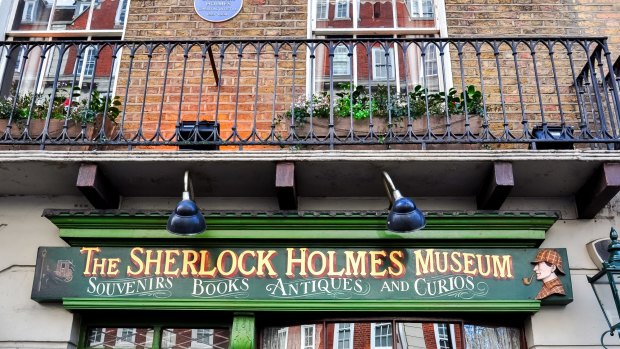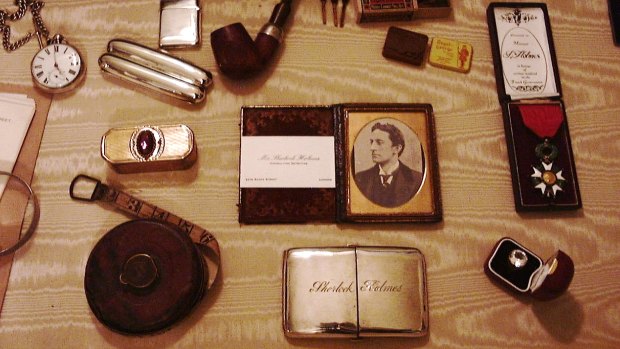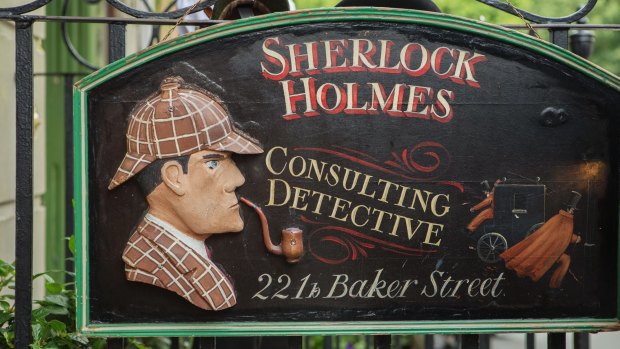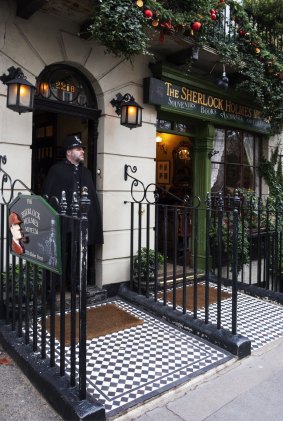This was published 4 years ago
Sherlock Holmes Museum, London: The museum Arthur Conan Doyle never wanted to see
By Steve Meacham

The Sherlock Holmes Museum, London.Credit: iStock
Patients at St Bartholomew's Hospital, in the shadow of London's St Paul's Cathedral, are often baffled by the plaque confronting them when they're well enough to venture to the hospital museum.
This plaque is brown and rectangular, unlike the round blue versions often seen around London for Nobel prize winners and literary giants. It reads: "At this place, New Years Day, 1881 were spoken these deathless words."
And they were?

Exhibits at the Sherlock Holmes Museum.
"You have been in Afghanistan, I perceive."
The first words spoken by Sherlock Holmes to Dr John Watson hinted at what was to come.
A Study in Scarlet, written by another medico - Scotsman Sir Arthur Conan Doyle - was published in The Strand magazine in 1887, introducing the world's most famous detective, and changing crime fiction forever with its formula: flawed hero, diligent companion, complicated family, ultra smart criminal rival.

The Sherlock Holmes museum is located on Baker Street and is dedicated to the fictional detective Sherlock Holmes.Credit: iStock
In the story, Holmes is using "Bart's" laboratory for his experiments on blood stains when a mutual friend introduces him to Watson, who is also looking for comfortable lodgings in central London. The former army doctor (indeed, newly returned from Afghanistan) agrees to co-rent an apartment at 221B Baker Street. The premises are let by long-suffering landlady, Mrs Hudson - and one of fiction's most enduring triumvirates is born.
Of course, there is no 221B in London's Baker Street. But almost directly across the road (close to the Madame Tussaud queues) you'll find the Sherlock Holmes Museum. Conan Doyle would have hated it.
Ironically for someone who believed in seances, the author tried to kill off Holmes several times - most notably in The Final Problem, when Holmes and his nemesis, Professor Moriarty, plunged to their "deaths" in Switzerland's Reichenbach Falls.

A policeman stands at the entrance to the Sherlock Holmes Museum, at the mythical 221B of Baker Street in London, United Kingdom, dedicated to the famous detective.Credit: iStock
Long after his death, Conan-Doyle's descendants kept up the author's objection to a museum commemorating his fictional character. Yet today, coach loads of Holmes devotees queue every day outside the museum.
It helps that each generation has reinvented the relationship between Holmes, Watson, Mrs Hudson, Inspector Lestrade and Mycroft, Sherlock's smarter brother.
Newer fans have been introduced by the BBC's contemporary version of Sherlock, starring Benedict Cumberbatch, Martin Freeman and Una Stubbs (which re-visits many of the original locations and plot points).
Is it worth visiting? Yes, though book online to avoid the queues.
The narrow house - with its steep stairs, open fire places and chamber pots - is authentically accurate to the books.
Look, there's the violin, drug paraphernalia, disguises, comfy chair to welcome uncomfortable clients, text books and chemical kit to decipher complex clues (long before forensic science itself was invented).
But it's "Holmes's bedroom" I find most surprising. The single bed seems too short for Holmes. "Not at all," replies our costumed guide. "Watson described Holmes as being uncommonly tall, about six feet (182 cm). And this bed would have suited him perfectly."
Most fictional detectives travel far afield. Poirot - like his inventor, Agatha Christie - ventured widely, solving murders on the Orient Express, the Nile and Mesopotamia.
But Holmes rarely strayed from London - and if he did (such as his trip to the Devon moors to solve his most famous case, The Hound of the Baskervilles) it would be via a railway station.
Talking of the Baskerville case, it begins with a boot stolen from the Northumberland Hotel, close to Charing Cross Station.
The hotel no longer exists, but the pub on the site (now called the Sherlock Holmes) is a short walk from Trafalgar Square tube. There's a give-away when we walk in. Every TV is showing a black and white movie starring Basil Rathbone as Sherlock and Nigel Bruce as the thickest Watson in screen history.
Seems like a perfect moment to sample the steak and ale pie with mash, washed down by a pint of Greene King. Upstairs, there's a corner of the dining room set aside for a recreation of Holmes's study. True, the Holmes mannequin looks more like Vladimir Putin. But there's lots of references to particular stories among the tableau if you're a real Holmes nerd.
While we're at it, Charing Cross and Waterloo stations feature far more in Holmes mysteries than their north London equivalents such as King's Cross and Euston.
Why?
Conan Doyle lived in South Norwood, a respectable suburb of London way south of the Thames. So he was more familiar with the train timetables of London's southern terminus.
Elementary, my dear Watson.
THE DETAILS
VISIT
Sherlock Holmes Museum, sherlock-holmes.co.uk.
EAT
The Sherlock Holmes, greeneking-pubs.co.uk/pubs/greater-london/sherlock-holmes.
MORE
Sign up for the Traveller Deals newsletter
Get exclusive travel deals delivered straight to your inbox. Sign up now.